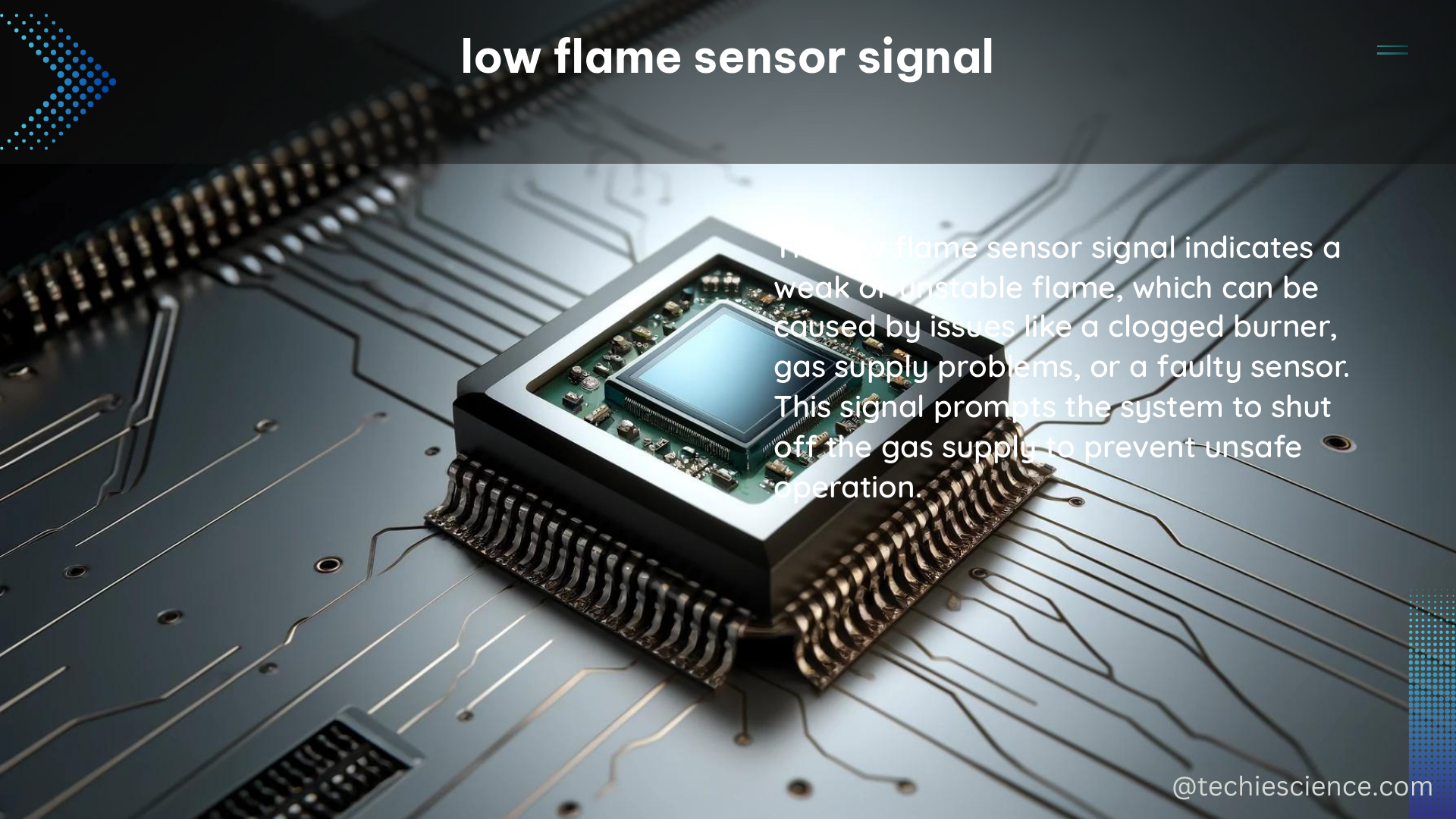Low flame sensor signals are crucial for ensuring the safe and efficient operation of gas appliances, such as furnaces, by detecting the presence of a flame and adjusting the gas supply accordingly. These sensors utilize electro-catalytic technology to measure changes in resistance when a combustible gas/air mixture passes over a hot catalyst surface, providing a direct correlation between the gas concentration and the sensor’s output signal.
Understanding the Technical Specifications of Low Flame Sensor Signals
The technical specifications of low flame sensor signals can vary depending on the specific model and manufacturer, but they generally share common characteristics:
Sensitivity and Lower Explosive Limit (LEL)
The sensitivity of low flame sensor signals is typically expressed in terms of the Lower Explosive Limit (LEL), which is the lowest concentration of a gas or vapor that can form an explosive mixture with air. For example, the University of Central Florida’s “Module for Rapid Detection of Gases from Fire and Smoke” project aims to develop a cost-effective, portable detection system that can quickly and quantitatively analyze and monitor toxic and dangerous gases mixed with unwanted aerosols, such as smoke, soot, dust, mist, fog, haze, and fumes in real-time. This system is particularly relevant given the increasing number of wildfires in the United States and the need for precise sensing and detection of hazardous, toxic, and flammable gases during fire accidents.
The LEL values for common flammable gases are as follows:
| Gas | LEL (% by volume in air) |
|---|---|
| Methane | 5.0% |
| Propane | 2.1% |
| Butane | 1.8% |
| Hydrogen | 4.0% |
Ensuring that the low flame sensor can reliably detect gas concentrations well below the LEL is crucial for preventing explosive conditions and ensuring the safe operation of gas appliances.
Response Time
In addition to sensitivity, the response time of low flame sensor signals is also an important factor to consider. Infrared (IR) absorption-based gas detectors, for example, have a very fast speed of response, typically less than 10 seconds, compared to catalytic type sensors. This rapid response time is particularly important in situations where the quick detection of gas leaks or other hazardous conditions is critical for ensuring safety.
Sensor Mounting and Flame Arrestor
In terms of DIY maintenance and troubleshooting, it is important to ensure that the low flame sensor is mounted in a strong metal housing behind a flame arrestor. This configuration prevents the propagation of any flame to the outside atmosphere, which could potentially ignite any flammable gases or vapors in the surrounding environment.
Calibration and Maintenance of Low Flame Sensor Signals

Proper calibration and maintenance of low flame sensor signals are essential for ensuring their accuracy and longevity. Manufacturers typically provide guidelines for these procedures, which may include:
- Weekly checks of the sensor’s response to a known gas concentration
- Adjustments to the zero and span potentiometers to ensure accurate readings
- Cleaning or replacement of the sensor element as needed
- Verification of the sensor’s mounting and the integrity of the flame arrestor
Following these guidelines can help maintain the reliability and performance of the low flame sensor over time, reducing the risk of false alarms or missed detections.
Emerging Technologies and Future Trends
As the demand for more advanced and reliable gas detection systems continues to grow, particularly in the context of wildfire management and industrial safety, researchers and manufacturers are exploring new technologies to enhance the capabilities of low flame sensor signals.
One such example is the development of multi-gas detection systems that can simultaneously monitor a wide range of hazardous gases, including flammable, toxic, and asphyxiant compounds. These systems often incorporate a combination of sensor technologies, such as electrochemical, infrared, and metal-oxide semiconductor sensors, to provide a comprehensive and accurate assessment of the gas environment.
Additionally, the integration of low flame sensor signals with Internet of Things (IoT) and cloud-based monitoring platforms is becoming increasingly common. This allows for real-time data transmission, remote monitoring, and predictive maintenance, further improving the safety and efficiency of gas appliance operations.
Conclusion
Low flame sensor signals play a critical role in ensuring the safe and efficient operation of gas appliances. By understanding the technical specifications, calibration requirements, and emerging trends in this field, users and technicians can ensure the longevity and accuracy of these essential safety devices.
References:
– Reddit Discussion on Electrical Efficiency
– Honeywell Gas Detection Handbook
– FEMA Project Abstracts on Gas Detection

The lambdageeks.com Core SME Team is a group of experienced subject matter experts from diverse scientific and technical fields including Physics, Chemistry, Technology,Electronics & Electrical Engineering, Automotive, Mechanical Engineering. Our team collaborates to create high-quality, well-researched articles on a wide range of science and technology topics for the lambdageeks.com website.
All Our Senior SME are having more than 7 Years of experience in the respective fields . They are either Working Industry Professionals or assocaited With different Universities. Refer Our Authors Page to get to know About our Core SMEs.